 |
Tamatha
Barbeau, Ph.D. Professor of Biology Coordinator: Veterinary Studies Program Coordinator: Program for Undergraduate Research (PURE) |
About
Me
 |
Tamatha
Barbeau, Ph.D. Professor of Biology Coordinator: Veterinary Studies Program Coordinator: Program for Undergraduate Research (PURE) |
About
Me
 |
Here I am hiking in Banff National Forest during the summer of 2000. I'm perched on a tree precariously over a icy mountain stream. |
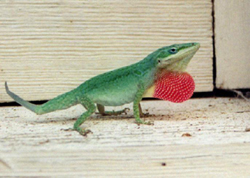 A green anole showing his colored dewlap to intimidate rival males and attract females |
I
love animals and am forever curious about them. You can read all day about
ecosystems and the animals that live in them but it just pales in comparison
to getting outside and discovering them for yourself. I enjoy finding
unusual animals like this green anole (Anolis carolinenesis)
(left) or this loggerhead musk turtle (Sternotherus minor)
(right). Sure I might get muddy and disheveled seeking out these critters
and observing how and where they live. That's part of the fun and makes
you appreciate how exquisitely they are adapted to their habitat.
|
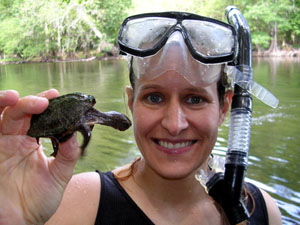 A loggerhead musk turtle in a Florida spring |
 |
To
the left is a male bullfrog (Rana catesbeiana) calling from a pond.
Male and female bullfrogs exhibit sexual dimorphism, which means males and
females have a different appearance. The males call (females don't) and
also have a tympanic membrane that is about as large, if not larger, than
their eye. The tympanic membrane - seen just behind this frog's eyes - is
a structure for hearing. On the right is a common snapping turtle (Chelydra serpentina) They tend to be smaller than the Alligator snapping turtle (seen at the top of this page) but have a wider distribution in the United States than do the Alligator snappers. Their hard keratinous hook-shaped mouths of the common snapping turtle are no less dangerous than that of the Alligator snapper, so always respect the business end of such turtles! |
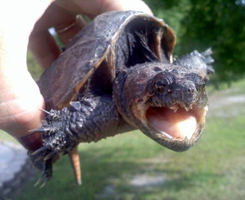 A common snapping turtle I saved from the road and relocated to a pond. |
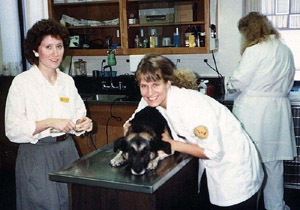 Tending to a dog with fellow Veterinary Technicians, Molly (left) and Lori (back, right) |
I
am also a licensed Veterinary Technician. I earned my Associates degree
in Veterinary Science Technology at SUNY Canton, N.Y. under the instruction
of Dr. Edward Gordon. Dr. Gordon was one of the best professors I'd ever
had as an undergraduate! I have worked at both a private practice (small/large
animal hospital), a zoo, and a dairy farm in upstate New York. Being a
vet. tech. was valuable experience and an exciting job.
|
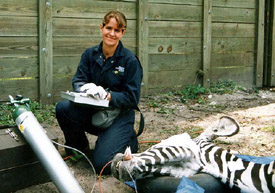 Anesthesia of a zebra at a zoo |
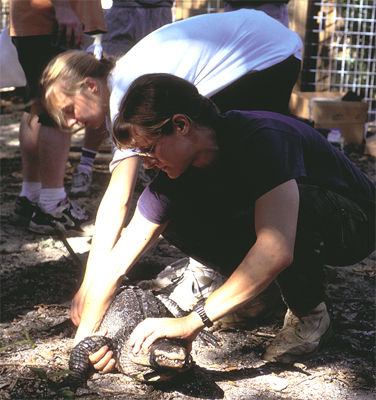 Here I am putting my Vet Tech skills to use restraining an American Alligator for drawing blood, taking measurements, and performing overall health exams. |
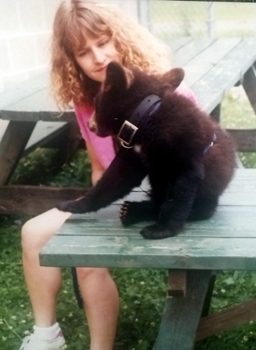 Here I am with a Black bear cub I helped raise at Burnet Park Zoo in Syracuse, NY. "Sheila" was rescused by the DNR from an individual that was keeping her illegally (without permit) in his home. Unfortunately he had her de-clawed and even had her baby teeth filed down. What a travesty! Fortunately, her adult teeth grew in, but without her front claws she could never be re-introduced into the wild. She found a good, permanent home at a zoo. People - even with the best intentions - should NEVER keep wildlife as pets. They are wild and deserve a chance at being free. Furthermore, large animals (like this bear became) are unpredictable and potentially dangerous. |
 |
Here I am visiting with my family and my husband's family in upstate New York. I am in the center of top row and my husband (Greg Pryor) is to my right, and my stepfather (Gary) is to my left. My family has been a great influence and fostered much of my love for animals and the outdoors. We camped almost every summer during my childhood, and my father (lower left) took me fishing while my mother (second in from left on bottom) was always tolerant when I brought all sorts of critters home. The two on the lower right are Greg's parents (Bob and Peg). |
|
Bowfin |
In addition to just exploring I also love to go fishing. I have probably been fishing since I was four (thanks Dad!) and have continued to enjoy it. Here you see my first bowfin (Amia calva) catch (left). Bowfin are mysterious and fiesty fish. Their origin dates back to the Cretaceous Period - more than 100,000,000 years ago. They are called bowfin because of their long dorsal fin. They have been known to exceed 3 feet and 20 lbs! They put up quite a fight and have razor-sharp teeth which requires careful handling. The fish on the right is a redfish (Sciaenops ocellatus), also known as red drum, channel bass, bull red, or rat reds. I had tried for several years to catch a redfish and succeeded only last year (2003) fishing at Cedar Key, Florida. It was 24 inches long and about 5 lbs. Redfish are saltwater fish and grow to a maximum size of about 90 lbs in the Atlantic and about 60 lbs in the Gulf of Mexico. |
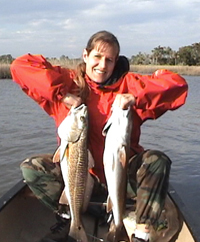 Redfish |
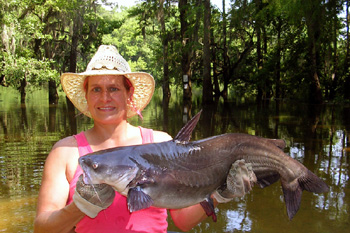 |
Last
year (2009) I FINALLY caught a blue catfish (right). It was so exciting!
Well, on the sliding scale of catfish size it was not a monster (about 24
lbs) but, nonetheless I was ecstatic! Blue catfish (Ictalurus furcatus)
can get incredibly gargantuan (see pics). They are also called Channel cat,
hump-back blue, or even "whisker kitty" (because of their long
sensory "whiskers" on their face). These big boys can live 15
- 20 years and average 40 - 80 lbs. The current record is 111 lbs! Mark Twain wrote about these colossal catfish in Mississippi and claimed to have seen some as large as 185 - 250 lbs. Click HERE to read more. |
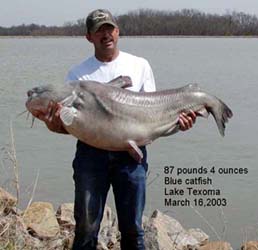 |
|
|
While
my husband (Greg Pryor) and I go out exploring we enjoy filming the assortment
of animal species we find. We have had quite a few adventures and have stumbled
across things we had never seen before. One such example is when we found a frightening looking insect. It was bright green with devilish black and bright orange horns on its head. Although it looked ferocious and highly toxic it was actually harmless. This impressive creature was the Hickory horned devil (Citheronia regalis). It was as thick around as a cigar and about 6 inches long. When it was disturbed it reared up on its back legs and thrashed its head menacingly towards us. These catepillars spend all summer feeding on the leaves of such trees as the hickory, walnut, or sweet gum. When they grow large enough they stop eating, climb down from their trees, and burrow into the ground to pupate. It can take all winter for them transform within their pupae and emerge in the spring as the beautiful adult royal walnut moth (or regal moth). |
|
|
Another
pastime I enjoyed while living in Florida was working at the St
Augustine Alligator Farm with a good friend of mine Kent
Vliet (right). Kent is an expert on crocodilian biology and behavior.
It was at the St. Augustine park that I first saw an Alligator snapping
turtle (Macroclemys temminckii). They are amazing reptiles!
They are the largest freshwater turtle in North America and can reach
sizes up to 200 lbs! The one I handled in the video (linked in the photo
at the top of this page) was only about 70 lbs and very hard to handle.
I don't recommend handling these animals unless you have some training,
like I did. They are highly aquatic (like many turtles) and inhabit large
freshwater streams or tributaries associated with the Gulf of Mexico. |
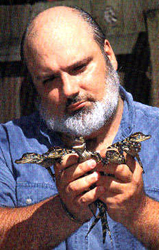 Dr. Kent Vliet |
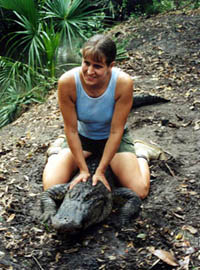 Making friends with an American alligator 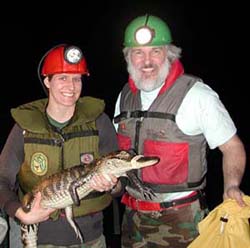 Me and my advisor, Lou Guillette. |
Here
I am making friends with an American Alligator (Alligator mississipiensis)
at the St. Augustine Alligator Farm (left). I was helping Dr. Vliet capture
"gators" to draw blood and check their overall health during a
routine examination. The American Alligator is a large, semi-aquatic reptile
that is related to crocodiles but are not as large (only 6-14 ft in length).
They can weigh up to 500 lbs and are common in swamps, rivers, bayous, and
marshes of the southern United States. On the right I am showing some undergraduate students at the University of Florida about how contaminants affect the reproductive morphology of these alligators. Contaminants such as DDT have been found to be estrogenic - this means that they act like estrogens on the body and can cause development of female characteristics in males, and suppress development of some male characteristics. Male alligators exposed to DDT have been shown to have a decreased penis size (yikes!). Much of this research was pioneered by my Ph.D. advisor and mentor at UF, Lou Guillette (see lower left). Alligators, unfortunately, are very poorly understood reptiles. These magnificent animals were once on the verge of extinction due to overhunting and contaminated habitats. They have since made a tremendous comeback over the past 30 years due to strict protection laws. They are undoubtedly dangerous animals and should always be treated with caution. They normally avoid people but as human populations expand the alligator's habitat is threatened and conflicts occur between alligators and people. This problem is made worse when people feed alligators mistakenly believing they are being nice to the animals when in fact they serve to reduce its natural fear of people. Feeding them only encourages them to approach people as "food sources" rather than to flee from them (a much better behavior). |
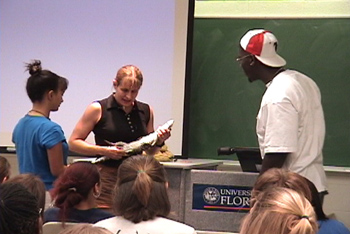 Showing gator "parts" to some brave undergraduates at UF |
|
|
Much to my enjoyment this winter (2005) I discovered Spring peepers (Pseudacris crucifer) near my house. Even in near-freezing temperatures they go about their business of calling and finding mates. I don't know how such tiny creatures manage to keep active all night when I have to bundle up in layers just to watch them for half an hour! It is just the fundamental difference between ectotherms (them) and endotherms (us). |
|
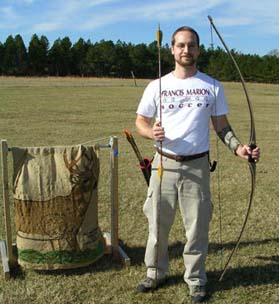 Greg "Bullseye" Pryor |
My husband and I have many hobbies outside of teaching and research at Francis Marion University. We love archery and fishing. |
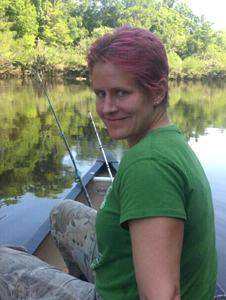 Me fishing from our canoe. |
|
Here
are some images of our life on the homestead
|
||
 Me and Greg with our garden harvest. |
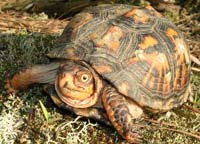 A box turtle in a field of blackberries |
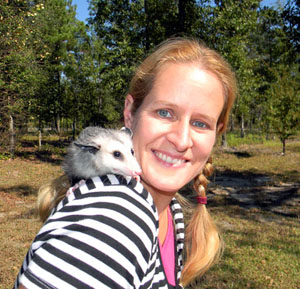 One of the orphaned opposums that I raised and released. |
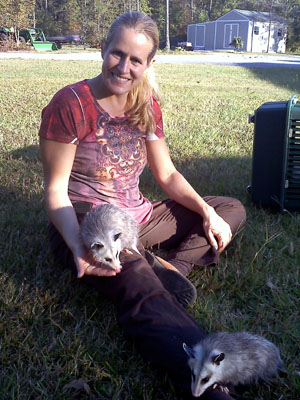 Me with my" possies")! Opposums are generally not tame - they are wild animals and should be treated with respect and avoidance if possible. However, these animals were orphaned as babies when their mom was hit by a car. I raised them so they were friendly and trusting towards me. Once they were large enough I gradually re-introduced them into the wild, where they really belong. They hung around my yard for a few months, returning for snacks I left out for them, but then gradually they become more independent - as they should be - and moved away on their own. |
 A copperhead found near the driveway. |
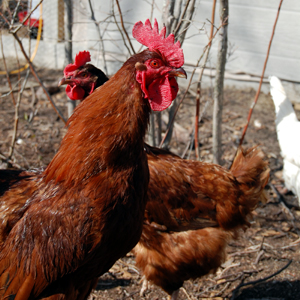 Here are some of my Rhode Island Red chickens. The male (foreground) vigorously defends his hens (background). You must watch your back when entering the chicken yard when he's around. He likes to make sneak attacks if you're not watching him! Little rascal! |
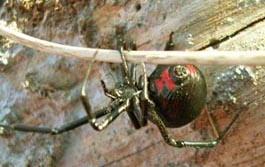 A Black widow found under a log by our house. Yikes! Black widow spiders are actually pretty common in the South. You can find them under rotting logs, in old barns and sheds, or even in the garden! I found one once on a garden hose. Contrary to what people commonly believe, Black widow spider bites are rarely fatal. Their venom is highly toxic and can cause intense pain, inflammation, and tissue damage at the site of a bite. Extreme pain and nausea are often associated with widow bites but fatalities are rare unless a young child, elderly or immuno-compromised person is bitten. Still,much caution should be taken around these arachnids. |
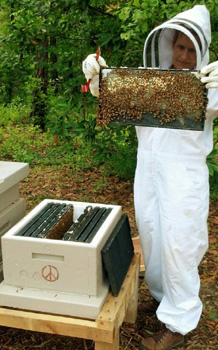 Examining a frame of honeybees, which we keep for both honey and pollination of our gardens. |
 My goats Olive, Jesse, and Cypress (left to right). Goats are intelligent and affectionate livestock animals. We keep and breed them for goat milk. They form close bonds with each other and, if you spend enough time with them, their human caretakers as well. My hoofed kids follow me everywhere I go around the pasture and love to sit with me on their basking platform and get scratched. |
 This is our main garden. We try and grow most of what we eat on the homestead. That works great during the spring and summer. The winter - not so much, unless we've canned or frozen the produce. |
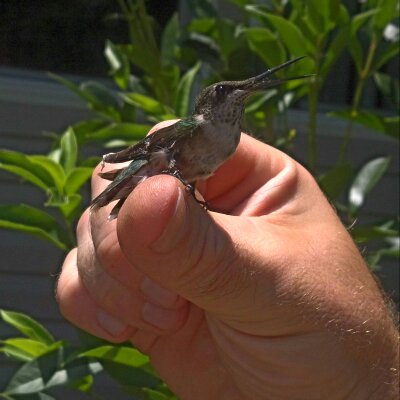 Here is a female Ruby-throated hummingbird (Archilochus colubris) that got trapped in our garage. She tired herself out, so when we finally caught her she had to rest on Greg's hand for a few minutes before flying away. Such a tiny bird - seemingly so fragile - yet they make an amazing journey twice a year. They arrive in South Carolina from the southern areas of Mexico, Central America, and on Caribbean islands around March, stay through the warm summer months, and then depart around August, with males departing slightly earlier than females. I look forward to seeing them arrive each spring! |
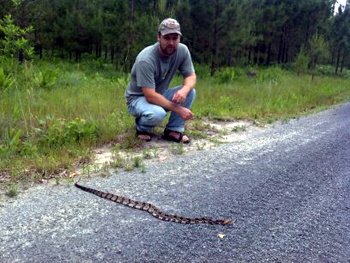 Here is a Canebrake rattlesnake - a subspecies of the Timber rattlesnake (Crotalus horridus) - crossing our driveway during the early Fall. Canebrakes are a venomous pitviper that ranges in size from 3 - 5 feet as adults. The largest we have seen on our property was a 5 ft female. No - we didn't kill her! They have a right to be here and many populations of rattlesnake species are on the decline due to "rattlesnake roundups" out West and the prevalence of rampant killing of rattlesnakes on sight, even when they aren't posing any immediate threat. Any canebrakes found close to our house are carefully re-located to the "back 40 acres", as they say. This female never even rattled. We kept a respectful distance and, feeling unthreatened, she simply slowly slithered away into the brush. AWESOME! |